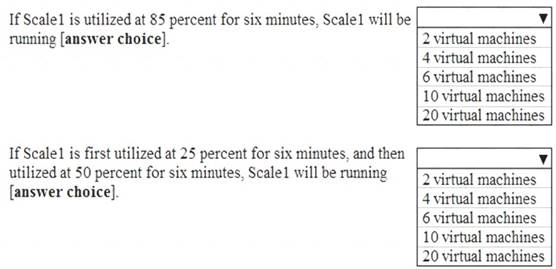- (Exam Topic 6)
You have an Azure subscription that contains the storage accounts shown in the following table.
You plan to manage the data stored in the accounts by using lifecycle management rules. To which storage accounts can you apply lifecycle management rules?
Correct Answer:
D
Reference:
https://docs.microsoft.com/en-us/azure/storage/blobs/storage-lifecycle-management-concepts?tabs=azure-portal
- (Exam Topic 5)
Note: This question is part of a series of questions that present the same scenario. Each question in the series contains a unique solution that might meet the stated goals. Some question sets might have more than one correct solution, while others might not have a correct solution.
After you answer a question in this section, you will NOT be able to return to it. As a result, these questions will not appear in the review screen.
You have an app named App1 that is installed on two Azure virtual machines named VM1 and VM2. Connections to App1 are managed by using an Azure Load Balancer.
The effective network security configurations for VM2 are shown in the following exhibit.
You discover that connections to App1 from 131.107.100.50 over TCP port 443 fail. You verify that the Load Balancer rules are configured correctly.
You need to ensure that connections to App1 can be established successfully from 131.107.100.50 over TCP port 443.
Solution: You modify the priority of the Allow_131.107.100.50 inbound security rule. Does this meet the goal?
Correct Answer:
B
The rule currently has the highest priority. Reference:
https://fastreroute.com/azure-network-security-groups-explained/ Allow_131.107.100.50 rule already has the highest priority.
https://docs.microsoft.com/en-us/azure/virtual-network/network-security-groups-overview
- (Exam Topic 5)
You have an Azure subscription.
You create the Azure Storage account shown in the following exhibit.
Use the drop-down menus to select the answer choice that completes each statement based on the information presented in the graphic.
NOTE: Each correct selection is worth one point.
Solution:
Box1: LRS will keep minimum three copies.
Box2: Changing the access tier from hot to cool will reduce the cost. In performance, standard is cheap.
In the Account kind, GPV2 is giving best price. Can be checked yourself using the pricing calculator on below link.
Reference:
https://azure.microsoft.com/en-in/pricing/calculator/?service=storage
Does this meet the goal?
Correct Answer:
A
- (Exam Topic 1)
You need to meet the technical requirement for VM4. What should you create and configure?
Correct Answer:
B
Scenario: Create a workflow to send an email message when the settings of VM4 are modified.
You can start an automated logic app workflow when specific events happen in Azure resources or third-party resources. These resources can publish those events to an Azure event grid. In turn, the event grid pushes those events to subscribers that have queues, webhooks, or event hubs as endpoints. As a subscriber, your logic app can wait for those events from the event grid before running automated workflows to perform tasks - without you writing any code.
References:
https://docs.microsoft.com/en-us/azure/event-grid/monitor-virtual-machine-changes-event-grid-logic-app
- (Exam Topic 4)
You have Azure subscription that includes following Azure file shares:
You have the following on-premises servers:
You create a Storage Sync Service named Sync1 and an Azure File Sync group named Group1. Group1 uses share1 as a cloud endpoint.
You register Server1 and Server2 in Sync1. You add D:Folder1 on Server1 as a server endpoint of Group1. For each of the following statements, select Yes if the statement is true. Otherwise, select No.
NOTE: Each correct selection is worth one point.
Solution:
Box 1: No
Group1 already has a cloud endpoint named Share1.
A sync group must contain one cloud endpoint, which represents an Azure file share and one or more server endpoints.
Box 2: NO
Box 3: Yes
Yes, one or more server endpoints can be added to the sync group. References:
https://docs.microsoft.com/en-us/azure/storage/file-sync/file-sync-server-endpoint-create?tabs=azure-portal
Does this meet the goal?
Correct Answer:
A

